The Nad Al Sheba Mini Forest: Urban Greening Insights
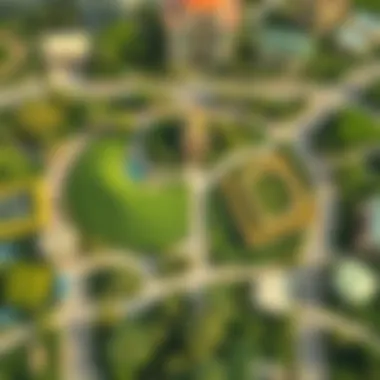
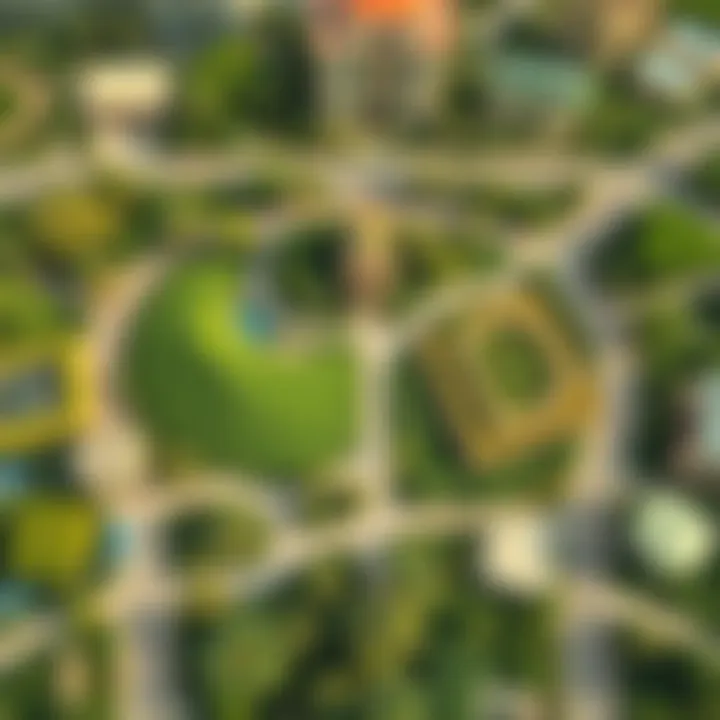
Intro
Urban greening has emerged as a critical strategy for fostering ecological balance in densely populated cities. In recent years, initiatives like the Nad Al Sheba Mini Forest have captured attention, serving as models of sustainable development. This project not only provides a green space for residents but also plays a vital role in addressing climate change and enhancing biodiversity in urban settings.
The Nad Al Sheba Mini Forest is more than just a patch of trees; it represents a forward-thinking approach to urban planning. Its creation stemmed from an understanding that, in cities where concrete dominates, green spaces can offer a breath of fresh air. This project aims to contribute to environmental awareness among residents while simultaneously fostering community engagement.
Exploring this mini forest allows stakeholders, including investors, urban planners, and community members, to grasp significant trends and opportunities within urban greening. The following sections will delve into the market trends, investment opportunities, and sustainable practices involved in such projects.
What to Expect
With this article, readers will gain a detailed understanding of how the Nad Al Sheba Mini Forest was conceived and executed. Key themes will include the ecological benefits of urban greening, the economic potential tied to these initiatives, and the active role of local communities in creating and maintaining such environments. By the end of the piece, the hope is to present a nuanced picture of why the mini forest stands as a paragon of urban greening efforts, paving the way for similar projects in the future.
Preamble to Urban Greening
Urban greening is emerging as a key player in the dance between cities and nature, striking a chord that reverberates through both environmental and social realms. This article zeroes in on the Nad Al Sheba Mini Forest, a prime example of how urban greening initiatives can breathe life into concrete jungles, transforming barren spaces into vibrant ecosystems.
Understanding the significance of urban greening goes beyond mere aesthetic appeal. It’s about planting the seeds for healthier urban environments that improve air quality and enhance the overall quality of life. With cities expanding at an unprecedented rate, the call for sustainable practices is louder than ever. Greening initiatives not only offer a remedy to urban heat but also serve as a sanctuary for diverse wildlife, creating habitats that were once lost to development.
Moreover, urban greening acts as a lens through which the interconnectedness of human activities and nature can be viewed, shedding light on the importance of preserving natural systems. When residents engage with these green spaces, they often develop a sense of ownership and responsibility, contributing to community well-being.
The concept extends beyond green belts and community gardens; it reaches into the heart of urban planning. Urban designers and planners are increasingly recognizing that integrating green spaces into city infrastructures can mitigate the effects of climate change while enhancing urban resilience.
In this article, we will explore the multifaceted nature of urban greening, illustrating its definition and profound importance, as well as the pivotal role that mini forests like the one at Nad Al Sheba play in our collective pursuit for sustainable urban living.
"Urban greening is not just about planting trees; it’s about creating a legacy for future generations in the midst of urban sprawl."
Through this examination, we aim to provide investors, analysts, and policymakers with comprehensive insights that lay the groundwork for informed decision-making and future developments in urban greening initiatives.
Overview of Nad Al Sheba Mini Forest
Urban greening efforts have become crucial in enhancing livability within crowded cities. The Nad Al Sheba Mini Forest stands out as a prime example of how small-scale green initiatives can create lasting impacts on ecological balance and community engagement. Situated within a vibrant metropolitan framework, this microcosm of biodiversity is not merely a patch of greenery but a reflection of modern urban planning principles that prioritize sustainability and environmental awareness.
Location and Accessibility
The Nad Al Sheba Mini Forest is strategically nestled in the Nad Al Sheba area, which is easily accessible from various parts of Dubai. Just a stone's throw away from bustling residential neighborhoods and commercial hubs, the forest occupies a prime spot that invites both local and visiting nature enthusiasts. This accessibility plays a vital role in fostering a culture of outdoor engagement among residents, as the mini forest can be a respite from the frenetic pace of urban life.
Notably, several public transport options are available nearby, making it easy for individuals and families to visit and explore the intricacies of this small forest. Streets lined with trees already provide a welcoming approach, enticing passersby to take a moment’s pause before venturing into the lush embrace of the mini forest. Moreover, pathways leading into the forest allow for inclusive access, ensuring that people of all abilities can experience the tranquility it offers.
Historical Context
Understanding the inception of the Nad Al Sheba Mini Forest requires a glance into Dubai’s broader urban greening narrative. In recent years, there's been a significant shift towards creating environmentally friendly spaces that counterbalance the intense urbanization experienced throughout the region. This shift is largely driven by a recognition of climate-related issues, including rising temperatures and the increasing frequency of heatwaves.
The conception of this particular mini forest can be traced back to initiatives focusing on sustainability and the desire to improve the urban ecosystem. Local authorities and environmental groups collaborated to transform an area historically viewed as underutilized into a thriving green space. Assembling a diverse collection of plant species native to the region not only bolstered the aesthetic appeal but also contributed positively to the ecological fabric of the urban landscape.
In the context of Dubai's ambitious plans for sustainable development, the existence of such spaces represents a critical step forward. It serves as a reminder that urban environments can gently coexist with nature, rather than solely serving concrete and steel. This perspective is essential for forward-thinking urban planning, where the city’s evolution includes a commitment to preserving and enhancing the natural world.
"By weaving nature into the urban fabric, we stitch together our future resilience against climate change."
In essence, the Nad Al Sheba Mini Forest encapsulates a pivotal stride in a city rapidly reshaping its relationship with the environment. The mix of community involvement, innovative design, and ecological foresight positions this project as an exemplary model for other urban areas considering similar initiatives.
Design and Implementation
The design and implementation of the Nad Al Sheba Mini Forest stand out as critical components ensuring its ultimate success. This area's layout, plant selection, and technological enhancements have merged to create a tapestry that is not only aesthetically pleasing but also practical and sustainable.
Architectural Concepts
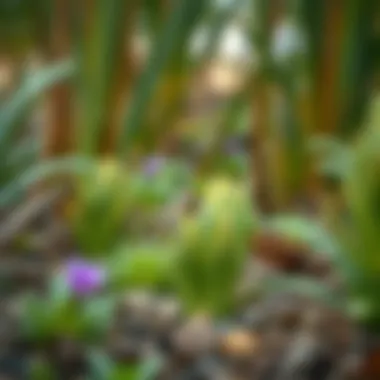
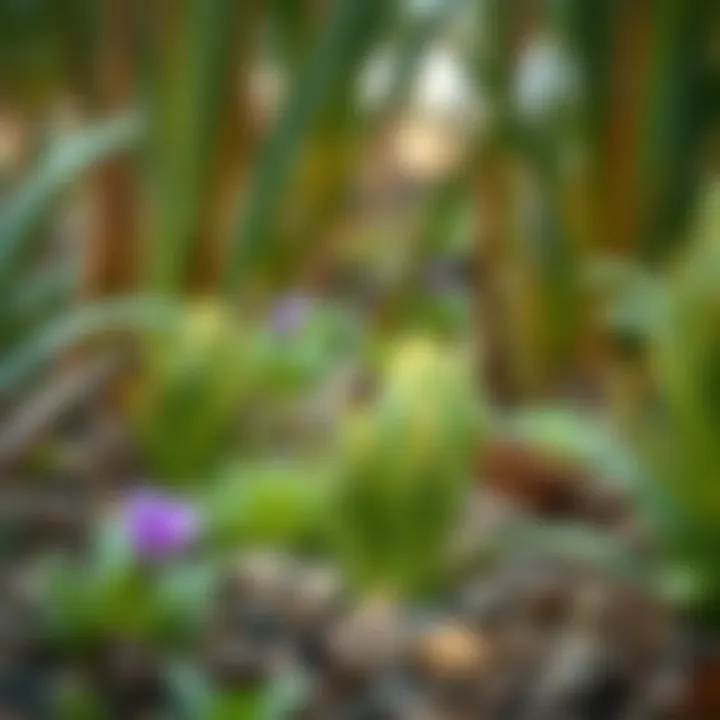
In designing the Nad Al Sheba Mini Forest, a deliberate approach to landscaping was paramount. The architects of this green space utilized principles that reflect natural ecosystems, which is essential for resilience against climate challenges. The idea revolved around creating a multi-layered habitat that supports various flora and fauna.
One of the more striking features is the way the pathways intertwine with the greenery. Instead of rigid lines, the trails meander through clusters of plants, mimicking natural wildlife trails. This not only makes the space more engaging for visitors but also contributes to sustainability by minimizing soil compaction. Careful thought here promotes biodiversity and encourages wildlife to flourish.
Moreover, green roofs and vertical gardens have been incorporated in some areas, blending the forest into the urban environment seamlessly. This architectural ingenuity allows for more green coverage, reduces urban heat, and enhances air quality—all critical aspects of urban greening.
Plant Selection and Biodiversity
The selection of plants in the Nad Al Sheba Mini Forest is rooted in the desire to promote biodiversity while ensuring that the ecosystem is self-sustaining. Native species were prioritized as they are typically more resilient to local pests and diseases.
- Acacia trees are a prominent feature, providing vital shade and habitat for various birds and insects.
- Desert roses and other drought-tolerant species illustrate the forethought given to plant selection, ensuring reduced water consumption—important in a desert climate like Dubai's.
Biodiversity doesn't only enhance aesthetic appeal; it fosters ecological balance. A diverse plant community supports different wildlife, from pollinators to small mammals. This interconnectedness is paramount, as each species plays a role in ecosystem health.
Technology Integration
In this urban forest, technology plays a pivotal role, enhancing both the management and accessibility of the space. The integration of smart irrigation systems has been implemented to ensure that water use is efficient, particularly important in arid environments. These systems use sensors to measure soil moisture and automatically adjust watering schedules, preventing waste.
Additionally, user-friendly apps provide visitors with information regarding the flora and fauna present. Such applications can help educate the public about the importance of local ecosystems and promote active participation in conservation activities.
"Technology is not just a tool; it's a pathway to deeper engagement with nature."
Overall, the design and implementation aspects of the Nad Al Sheba Mini Forest reflect a balance of natural beauty and innovative thinking. It's not only about planting trees; it’s about stitching together a thriving ecosystem within an urban setting. By combining careful architectural strategies, strategic plant selection, and smart technology, this urban greening initiative serves as a model for future projects, aiming to mend the city-nature divide.
Ecological Impact
Urban greening, particularly through initiatives like the Nad Al Sheba Mini Forest, is pivotal in promoting ecological harmony within city landscapes. This section dives into two major constituents: wildlife habitat preservation and climate mitigation, which serve as cornerstones of the environmental benefits stemming from urban forests. With urbanization radically altering natural habitats, the mini forest concept emerges as a beacon of hope. Its existence not merely beautifies an area but also sets the stage for rejuvenating ecology in urban environments.
Wildlife Habitat Preservation
The Nad Al Sheba Mini Forest plays an essential role in offering sanctuary to various species. Imagine a bustling metropolis where golden sand dunes transition into vibrant green pockets. This transformation can be credited to a targeted focus on enhancing habitats for local fauna. The mini forest caters to birds, insects, and small mammals, giving them much-needed shelter, food sources, and breeding areas. Establishing interconnected green spaces allows wildlife to thrive, adapting to urban challenges.
Notably, a variety of flora has been strategically chosen. Indigenous plants, native to the region, provide food and nesting materials, vital for local wildlife. This creates a symbiotic relationship; as the animals flourish, they assist with pollination and seed dispersal, further promoting biodiversity in urban settings.
"Within these mini forests, we find life—and with life, we discover balance."
Creating environments that support wildlife fosters not just preservation but also education. Community members who see species up close, be it a flock of vibrant birds flitting about or shy critters scurrying through the underbrush, develop a deeper connection to nature. Such experiences can spark interest in ecology and conservation, encouraging future generations to advocate for environmental wellbeing.
Climate Mitigation
The implications of climate change are alarming, and as urban areas swell, cities become significant contributors to global warming. The Nad Al Sheba Mini Forest aims to counteract this by absorbing carbon dioxide, thereby aiding in climate mitigation. The trees and plants integrated into its design act as natural carbon sinks, capturing greenhouse gases from the atmosphere. This process ultimately lessens local air pollution, clearing the way for a healthier urban environment.
Additionally, these forests provide a cooling effect. During scorching summer months, urban heat can turn city streets into frying pans. The presence of trees and greenery helps to reduce surface temperatures, creating a more tempered microclimate. As the heat dissipates, energy consumption for air conditioning may drop, leading to reduced energy costs and lower fossil fuel consumption.
- Organizing community events around tree planting promotes awareness.
- Residents are encouraged to participate in carbon tracking measures, seeing firsthand the effect they can make.
As awareness around climate issues grows, so too does the appetite for community action. Urban greening projects provide platforms for such initiatives. With more local engagement and passion for sustainability, it’s likely that climate mitigation efforts will flourish as well.
Community Engagement
Community engagement is a cornerstone of urban greening projects like the Nad Al Sheba Mini Forest. It not only creates a sense of ownership among the residents but also ensures the long-term sustainability of such initiatives. When communities are actively involved, they tend to care more about the green spaces around them, which can translate into enhanced ecological and social benefits.
Successful community engagement in urban greening goes beyond mere participation; it involves education, advocacy, and collaborative efforts that resonate with the local populace's values and needs. This multifaceted approach encourages active participation from individuals of all ages, making environmental stewardship a shared responsibility.
By fostering an ongoing dialogue between stakeholders—residents, local government, and environmental organizations—project managers can tailor their efforts to reflect the community’s unique identity. This enhances connection and commitment, allowing for a more profound collective impact. Without this engagement, even the most meticulously planned green spaces can suffer from neglect or misuse.
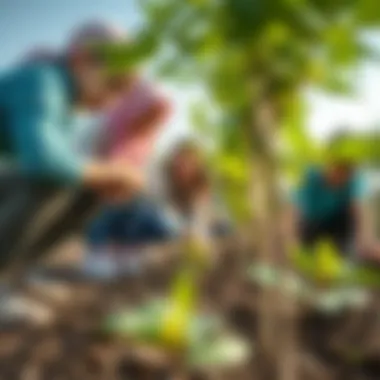
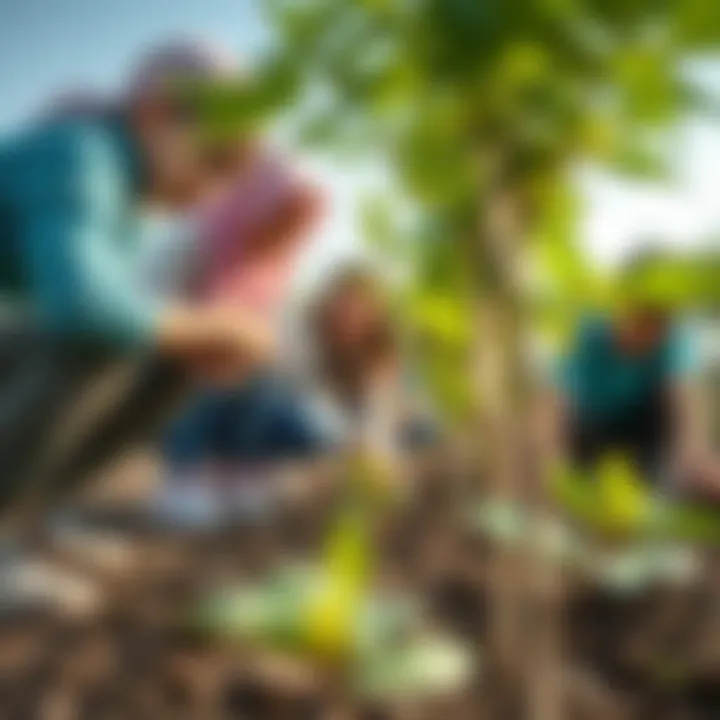
“A community that nurtures its environment is a community that thrives.”
Educational Programs
Educational initiatives play a pivotal role in community engagement efforts at the Nad Al Sheba Mini Forest. These programs instill a sense of environmental stewardship among local residents, particularly the youth. Schools often partner with local organizations to provide workshops that teach students about the importance of biodiversity, conservation, and sustainable practices.
Through hands-on activities, students participate in tree planting days, learning firsthand about the importance of flora in their urban surroundings. Workshops on topics such as the local ecosystem and the impacts of climate change serve as a valuable resource for both students and parents, fostering a sense of collective responsibility.
Some examples of educational programs include:
- Nature Walks: Guided tours that educate participants about the various species found within the mini forest, focusing on both plant life and wildlife habitats.
- Seasonal Camps: Activities during school breaks that involve a combination of fun and learning.
- Workshops for Adults: Programs designed to educate adults about home gardening, sustainable landscaping, and other relevant topics that emphasize green living.
Volunteering Opportunities
Volunteering initiatives are another crucial component of engaging the community at the Nad Al Sheba Mini Forest. These opportunities not only help maintain the site but also foster a sense of unity and shared purpose among participants. Volunteers can take part in activities ranging from planting trees to organizing community clean-up drives.
Moreover, volunteering can have beneficial impacts beyond immediate community engagement. It offers residents a platform to develop leadership skills, enhance their social networks, and gain practical experience in environmental conservation efforts. Here are some ways locals can get involved:
- Tree Planting Events: Community members are invited to assist in planting new trees, which do not only beautify the space but also contribute to local biodiversity.
- Maintenance Days: Regularly scheduled days focused on tasks such as pruning, weeding, and general upkeep of the mini forest ensure its continued vitality.
- Special Events: Seasonal events, such as festivals or open houses, allow community members to showcase their connections to the mini forest while engaging with others.
Challenges Faced
Creating a thriving mini forest in the heart of an urban landscape, like Nad Al Sheba, comes with its own set of challenges. Recognizing these hurdles is crucial not just for future initiatives but for understanding the current ecosystem's delicate balance. Addressing issues such as securing adequate funding and ensuring ongoing maintenance can make or break a project that aims to foster both environmental conservation and community engagement. The dynamics at play here are complex, but they highlight significant elements related to sustainability and urban planning.
Funding and Resources
Financing is often the backbone of any successful urban greening project. The Nad Al Sheba Mini Forest required various forms of funding; it's not merely about having a budget but leveraging resources effectively. Initial funding likely came from government sources, non-profit organizations, and possibly private donations. Often, these projects attract financial attention due to their promise of ecological improvement and community involvement. It's paramount that stakeholders explore varied funding avenues to ensure long-term viability.
Key points to consider about funding include:
- Public-Private Partnerships: Collaboration between government bodies and private sectors can unlock more resources. This could involve businesses committing funds for corporate social responsibility initiatives.
- Grants and Sponsorships: Various organizations provide grants aimed at urban greening projects. Identifying such opportunities can significantly bolster funding.
- Local Community Involvement: Sometimes, community fundraising activities can bridge the financial gap. Involving residents in financing can enhance their investment in the project and promote ownership.
In a broader sense, these funding avenues must be sustained. Each dollar has to be stretched to its limits while ensuring all necessary resources are available to maintain the health and diversity of the forest. Without a clear visibility on finances, the risk of a project floundering grows exponentially.
Maintenance Issues
Even with the best design and funding strategies, maintaining a mini forest presents several challenges. Healthy ecosystems require regular assessments to monitor plant health and biodiversity. Maintenance isn't a once-a-year task; it's ongoing. Addressing issues as they arise is essential to sustaining the ecological integrity and ensuring the forest benefits the community as intended.
Consider these common maintenance concerns:
- Resource Allocation: Adequate staffing must be devoted to maintaining the forest. Volunteers can help, but a dedicated team ensures prompt and reliable care for plants and wildlife.
- Climate Factors: Local climate conditions can pose challenges. Seasonal variations impact plant growth and require adaptive measures such as irrigation systems or protective coverage during harsh weather.
- Wildlife Management: As the mini forest matures, it will attract various wildlife. While this is generally positive, it may also mean invasive species or pests that might threaten local flora. Regular monitoring and effective management strategies are needed here.
In summary, while the Nad Al Sheba Mini Forest offers a multitude of benefits in urban greening, addressing its funding and maintenance challenges is paramount. High-level comprehension of these issues is essential for urban planners, environmentalists, and community activists invested in the sustainability of similar projects.
"The success of urban greening initiatives like mini forests relies heavily on understanding and overcoming the challenges they face. Without deliberate action, even the best-laid plans can go awry."
In the field of urban greening, a proactive approach to tackling challenges can lead to thriving ecosystems woven into the fabric of city life.
Comparative Analysis with Other Urban Forests
Comparative analyses of urban forests offer essential insights into managing city green spaces and their environmental consequences. Understanding the Nad Al Sheba Mini Forest within the context of similar initiatives worldwide elevates our perception of its contributions to urban greening. By investigating how various projects tackle ecological, social, and technological nuances, we glean lessons that could ripple through future projects.
This section will highlight specific examples of urban forests in differing environments, showcasing how innovative designs and community engagement strategies alike have nurtured biodiversity and enhanced urban life. It aims to clarify the broader relevance of the Nad Al Sheba Forest, framing its successes and challenges in the dual lens of global and local contexts.
Global Perspectives
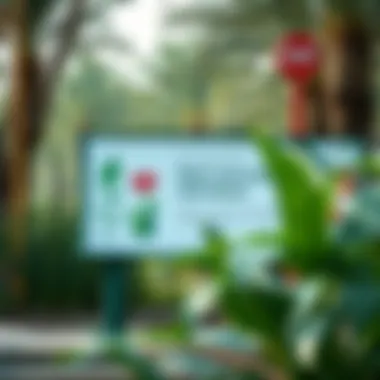

When examining global examples, cities around the world present diverse illustrations of urban forests thriving under various conditions. For instance, the Miyawaki Forest method, which originated in Japan, has seen successful adoption in many regions, including India and Brazil. This approach involves planting indigenous species in dense clusters that utilize minimal maintenance. The forests grow surprisingly fast, promoting sustainability and biodiversity. Key takeaways from this model include:
- Diversity of Plant Species: The introduction of multiple native plants fosters a rich habitat for wildlife, crucial for ecological balance.
- Rapid Growth: Dense planting creates competition, driving plants to grow quickly for sunlight, thus ensuring rapid biodiversity establishment.
Another powerful example comes from New York City, where parks like Central Park and smaller community gardens serve as lungs for the city, providing green spaces that boost mental health and local ecology.
The layer of comparison between these global illustrations and the Nad Al Sheba Mini Forest invites a unique dialogue about adapting successful practices. One can argue that integrating heavy local involvement is a common thread in these urban forestry strategies.
Local Examples
On a more localized level, projects like the Dubai Marina Green Trail and the Al Barsha Pond Park demonstrate how urban forests can be tailored more specifically to their environments and community needs. While these spaces vary in size, the impact they have on pollution levels, biodiversity, and community well-being is significant.
Key points drawn from these local examples include:
- Community Usage: Al Barsha Pond Park frequently hosts family events and sporting activities, reflecting how urban forests can cultivate social interactions.
- Environmental Goals: The Green Trail emphasizes reducing heat islands in urban areas, showcasing a focus on ecological aims amid urbanization.
Urban forests worldwide amplify biodiversity while providing crucial green spaces that fight pollution, particularly in cities where concrete storms dominate.
Further resources:
- Wikipedia - Urban Forest
- Britannica - Urban Ecology
- Community Forums on Reddit
Future Development Plans
As urban environments continue to expand and evolve, the significance of future development plans becomes increasingly crucial, especially for projects like the Nad Al Sheba Mini Forest. These plans not only ensure the longevity and sustainability of the green space but also enhance its role in promoting biodiversity, community engagement, and environmental awareness. In this section, we will delve into two key aspects: expansion prospects and sustainability initiatives that pave the way for the forest's future.
Expansion Prospects
When discussing expansion prospects, we consider how the current footprint of the Nad Al Sheba Mini Forest could be further developed to incorporate additional green areas, integrate more diverse plant species, and enhance recreational offerings for the community. Potential avenues for expansion may include:
- Adjacent lands: Identifying neighboring parcels that can be incorporated into the mini forest, creating a larger contiguous habitat that benefits both wildlife and residents.
- Vertical gardening: Utilizing innovative techniques like vertical gardens or green walls can increase greenery without requiring ground space. This could be particularly beneficial in urban settings like Nad Al Sheba.
- Community workshops: Developing interactive workshops that focus on the importance of tree planting and sustainability can foster community participation and support future expansions effectively.
The expansion of this mini forest would not only increase its ecological value but also provide the community with more space for outdoor activities and education regarding environmental stewardship.
Sustainability Initiatives
In addition to considering expansion, it’s vital to implement sustainability initiatives that will keep the Nad Al Sheba Mini Forest thriving. These initiatives could include:
- Water management systems: Developing rainwater harvesting techniques to efficiently manage water resources and reduce dependency on municipal supply.
- Native plant usage: Prioritizing the planting of native species, which require less maintenance and are better adapted to the local climate. They ultimately help preserve local biodiversity.
- Renewable energy sources: Integrating solar-powered lights and maintenance tools can reduce the carbon footprint of the forest maintenance operations.
- Awareness campaigns: Launching ongoing campaigns to educate visitors about the environmental benefits of urban greening, encouraging stewardship and responsible visits to the area.
By adopting these sustainability initiatives, the Nad Al Sheba Mini Forest can serve as a model for urban greening that is both adaptable and beneficial to the environment.
These strategies are not only essential for ensuring the mini forest's continued success but also for fostering a culture of environmental consciousness among city dwellers.
Epilogue
In summing up the lessons learned from the Nad Al Sheba Mini Forest, the pivotal role that urban greening initiatives play in enhancing city livability cannot be overstated. As cities expand and nature recedes, projects like this mini forest form a vital bridge connecting urban residents with the natural world. They not only serve aesthetic purposes but also function as critical ecological hubs, contributing to biodiversity and climate resilience.
Key Takeaways
- Enhanced Biodiversity: The mini forest serves as a sanctuary for various species, contributing to the preservation of local flora and fauna. This biodiversity is fundamental in maintaining ecological balance within urban settings.
- Community Engagement: The project fosters a sense of community through educational programs and volunteer opportunities, drawing locals into the environmental conservation dialogue.
- Climate Mitigation: Urban greening directly impacts climate resilience, helping to lower urban temperatures and improve air quality, which is crucial for public health.
- Social Cohesion: By creating spaces for recreation and connection, the forest encourages social interactions among residents, building a stronger community fabric.
Call to Action
In light of the successes observed at Nad Al Sheba, stakeholders—ranging from local governments to private investors—should seize the initiative to champion similar urban greening projects. Communities looking to invest in sustainability must prioritize the integration of green spaces into their urban planning.
- Advocate for Urban Greening: Attend local meetings, support policies that protect and expand green spaces, and voice the importance of such initiatives in your communities.
- Participate Actively: Engage in local planting days or educational workshops. Your involvement can make a difference in your neighborhood.
- Invest in Knowledge: Keep informed about sustainable practices in urban environments by visiting resources like National Park Service or engaging with local conservation groups.
"The future will be green, or not at all." – Herbert Marshall McLuhan
By committing to the vision of urban greening, we are not merely enhancing our cities; we are ensuring that future generations inherit a world where nature thrives alongside urban life. Now's the time for action.











